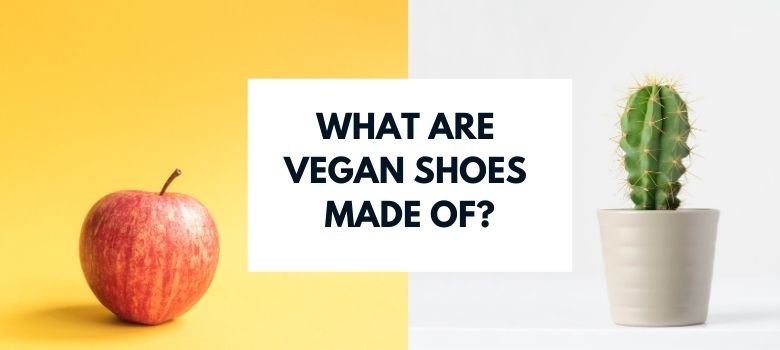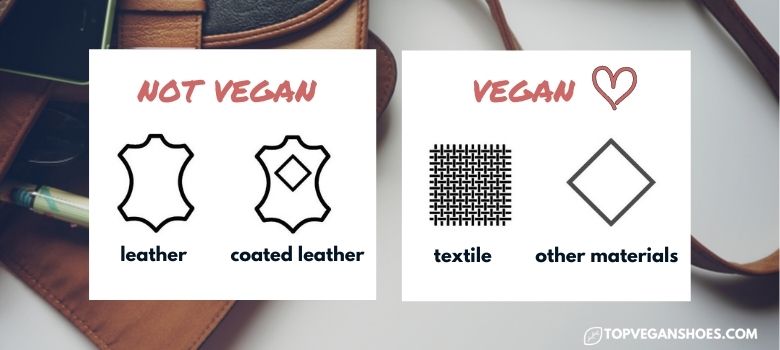Updated: January 2024

Gone are the days when we needed animal skin to make a great pair of shoes. The future of footwear seems to be entirely cruelty-free.
2. How to tell if shoes are vegan
3. What vegan materials are there
What Are Vegan Shoes Made of?
Vegan shoes are free from all animal products, such as leather, suede, fur, wool, silk, or sheepskin. No animal can be harmed in the shoe-making process, and no animal-derived ingredient can be found in the end product.
Vegan shoes are made of a variety of synthetic and plant-based materials such as polyurethane, hemp, or cotton. There is also a growing trend of using recycled plastic bottles, car tires, and yarn scraps as well as natural apple peel skins and other leftovers from the food industry.
Recently, brands like Adidas, Lululemon and Kering announced investing in an innovative vegan material called Mylo, a cell-grown fungal leather that has the potential to replace animal leather in the future.
Because of ethical concerns and the environmental impact of the leather industry, more and more people are looking to go faux. According to Grand View Research, the global market for vegan leather is expected to reach a volume of 85 billion dollars by 2025.
How to Tell if Shoes Are Vegan?
Vegan shoes are usually labeled ‘Vegan’ or ‘100% synthetic’. But if those labels are missing, check the sticker attached to the outsole.
Shoe producers are required to mark the entire composition of their footwear and show the list of materials used in all main parts of the shoe.
Here is what the shoe sticker symbols stand for:

Non-vegan materials – leather and coated leather – can be recognized by an image of animal hide.
Vegan materials have either an image of a textile (woven pattern) or a diamond. The diamond represents all other man-made materials such as PVC and rubber which are vegan by default.
If your shoe is missing the sticker, send an email to the producer. They are the best source in making sure all the ingredients in your shoe are vegan.
Is Shoe Glue Vegan?
The majority of shoe glue used today is vegan since synthetic glues have surpassed animal glues for effectiveness, low cost, and stability. Yet some companies might still use glues containing animal ingredients.
Non-vegan shoe glue is made by boiling animal connective tissue and bones together. Typically animals used in this process are horses, rabbits, and fish.
To make sure your shoes do not contain any animal glue, look for shoes with certified vegan labeling or contact the producer for more information.
Are Vegan Shoes Eco-Friendly?
When looking for eco-friendly shoes, you need to forget all about real leather and make friends with vegan footwear.
As vegan materials do not require to raise cattle, they help save tons of natural resources, preserve precious rainforests and reduce pollution caused by the leather tanning industry.
It is a common misconception that real leather is a more natural option. The truth is that leather uses loads of dangerous chemicals like chromium to prevent it from naturally decomposing. So when comparing leather to synthetic leathers, there is not much difference in biodegradability.
However, not all vegan leathers are created equal. It is better to steer clear from polyvinyl chloride (PVC) for it can release hazardous dioxins. Alternatively, materials like PU leather, recycled polyester, organic cotton, linen, or hemp are a lot more planet-friendly.
To assess the environmental impact of your vegan or leather shoes, you should also find out where they are made. As sustainable footwear brand Beyond Skin puts it:
“The majority of leather is tanned in countries with little or no environmental regulations or health and safety regulations, pollution from the tanneries is a major problem, ranked within the top ten worst toxic pollution issues in the world by the Blacksmith Institute.
So yeah, as far as shoe production goes, vegan shoes are your eco-friendly option.
What Vegan Materials are There?
These days, there are endless opportunities for vegan materials. From cotton and seaweed to fruit waste and coffee-plastic blends – virtually everything these days can be broken down to fibers and woven into an innovative fabric. Denim is also making a comeback in 2024.
Here is a list of all vegan materials divided into two categories: natural and synthetic. We also added a few materials that you need to be careful about: sometimes they are vegan, sometimes not.
Natural Vegan Materials
- Algae: dried algae biomass used as soft, eco-friendly cushioning
- Apple: biobased vegan leather derived from leftover apple skins
- Bamboo: natural textile made from the pulp of bamboo grass
- Canvas: sturdy fabric usually made from linen or cotton
- Cactus leather: organic plant-based material made from nopal cactus
- Chambray: lightweight natural fabric made from linen or cotton
- Chino: twill fabric made of 100% cotton
- Circulose™: biodegradable material made from recycled cotton
- Coffee: unique leather made from repurposed coffee grounds
- Coir: natural fiber extracted from the husk of the coconut
- Corduroy: striped fabric made from cotton (or cotton/polyester blend)
- Cork: versatile material from the bark of the cork oak
- Corn: innovative vegan leather made out of corn waste
- Cotton: soft, fluffy fiber that grows in a boll
- Denim: strong, durable textile made from cotton
- Flannelette: soft cotton fabric imitating flannel
- Hemp: durable fibers from the stalks of the Cannabis sativa plant
- Jute: vegetable fiber that can be spun into coarse, strong threads
- Linen: strong textile made from flax plant fibers
- Lyocell: cellulose fiber fabric made from dissolving pulp
- Natural rubber: elastic material made from a rubber tree
- Mylo™ – novel biobased material grown from mycelium cells
- Moleskin: heavy, woven cotton fabric
- MulbTex: vegan leather made from the paper pulp of mulberry tree leaves
- Muskin: unique vegan leather made from mushrooms
- Muslin: plain-woven cotton fabric
- Pinatex™: sustainable textile made from pineapple leaves
- Rayon: natural material made from recycled wood pulp
- Sateen: smooth fabric made from treated cotton fibers
- Seaweed: innovative fabric made by turning kelp into biodegradable yarn
- Soybeans: fabric made from liquefied soy protein
- Soysilk: a silk-like fiber made from soybean residue
- Tencel™: cellulose fiber, a brand name for a type of lyocell
- Velour: plush, knitted fabric typically made from cotton
- Velveteen: full, heavy cotton fabric imitating velvet
- Viscose: natural fiber derived from cellulose
Synthetic Vegan Materials
- Acrylic: synthetic fibers made from plastic fibers
- Faux fur: fur-like fabric typically made from polymeric fibers
- Faux snakeskin: printed and embossed polyurethane
- Faux wool: woolly fabric made from polymeric fibers
- Gore-Tex™: waterproof fabric made from stretched polytetrafluoroethylene
- Leatherette: another name for synthetic leather
- Microfiber: fine synthetic fiber made from polyester
- Microsuede: synthetic fabric made from pure polyester fibers
- Modal: semi-synthetic fabric made from beech tree pulp
- Nylon: versatile fabric made out of synthetic polymers
- Pleather: artificial leather made from plastic fabric
- Polyester: plastic-based fabric made of long-chain polymers
- Polyurethane (PU): synthetic fabric, more breathable and flexible than PVC
- PrimaLoft™: synthetic microfiber insulation material imitating down
- Recycled polyester (rPET): polyester fiber created by melting down existing plastic
- Recycled tires: rubber material made from reclaimed tires (used for outsoles)
- Rubber: elastic material made from petroleum products
- Spandex: lightweight, stretchable fabric made from polyurethane
- Ultrasuede™: ultra-fine, brushed microfiber fabric
- Vegan leather: artificial leather free from animal products
- Velcro: binding material typically made of nylon or polyester
- Vinyl: versatile fabric made of made from natural gas and chlorine
Be Careful With These Materials
Some materials may or may not be vegan. PETA has listed all maybe-materials you should be careful about before buying.
- Chenille: usually made from cotton but can also use wool or silk
- Chiffon: can be made from polyester, rayon, or silk
- Felt: can be made from polyester, rayon, or wool
- Flannel: can be made from cotton, polyester, or wool
- Fleece: can be synthetic or u made from natural wool
- Khaki: can be wool, cotton, or a combination of those two
- Jersey: can be made from cotton or wool
- Satin: can be made from rayon or silk
- Taffeta: can be synthetic or made from silk
- Velvet: can be synthetic or from mohair or wool
Summary
Keeping up to date on all the different materials is exhausting. This is why we have listed vegan materials to offer a quick check-up on if they are in fact animal-friendly. We keep this list updated as we find more and more new materials!
We have listed an extensive amount of materials that are 100% vegan. These include Faux fur, hemps, cork, algae and many others.
Vegan shoes are generally a lot more eco-friendly than leather shoes, especially if you prefer natural, ecological, and recycled vegan fabrics.
Yes, Pinatex leather is a vegan material derived from Pineapple leaves.